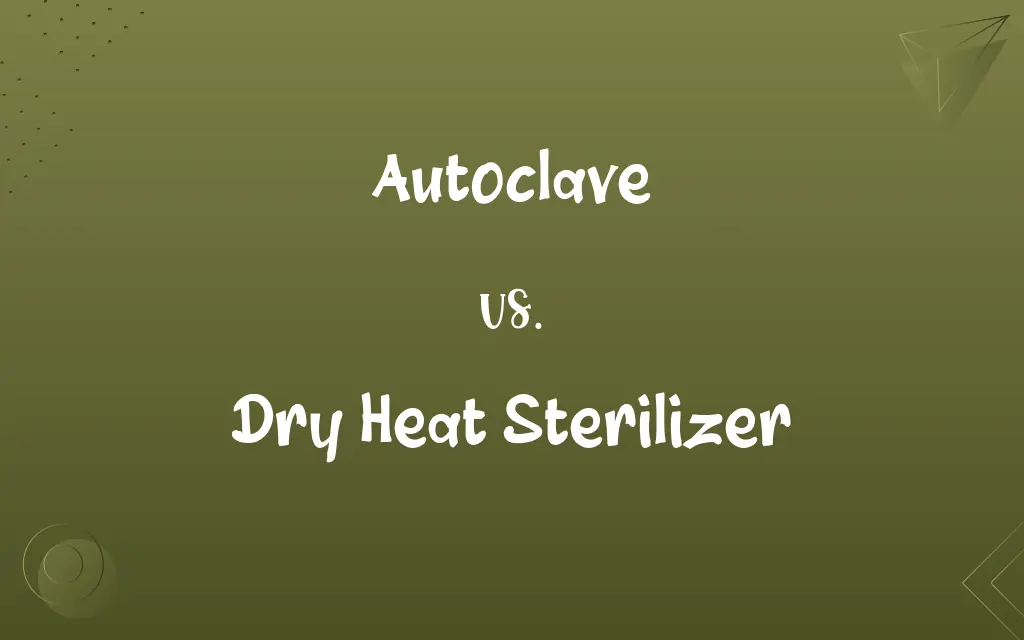Autoclave vs. Dry Heat Sterilizer: Know the Difference

By Shumaila Saeed || Published on February 1, 2024
An autoclave uses pressurized steam for sterilization, while a dry heat sterilizer employs high temperature without moisture to sterilize items.

Key Differences
An autoclave is a device that uses steam under pressure to sterilize medical and laboratory equipment. It's effective against all types of microorganisms, including spores. The autoclave operates at high temperatures, typically between 121-134°C, using the power of steam and pressure to achieve sterilization. In contrast, a dry heat sterilizer uses hot air to sterilize, typically operating at temperatures between 160-170°C for longer periods. Unlike autoclaves, dry heat sterilizers don't use moisture, making them suitable for materials that can't be exposed to moisture.
Shumaila Saeed
Feb 01, 2024
The method of sterilization in an autoclave involves both temperature and pressure. This combination allows the steam to penetrate materials more effectively, ensuring a high level of sterilization. It's particularly useful for sterilizing liquids and items that can withstand moisture and high pressure. On the other hand, a dry heat sterilizer relies solely on high temperatures. It's ideal for sterilizing materials that might corrode, rust, or be damaged by steam, such as powders, oils, and metal instruments.
Shumaila Saeed
Feb 01, 2024
Autoclaves are commonly used in medical facilities, dental offices, and laboratories due to their efficiency in quickly sterilizing a variety of tools and equipment. They are especially crucial for sterilizing items that come in direct contact with the human body. Dry heat sterilizers, while less common, are essential in situations where items cannot tolerate moisture, such as in certain laboratory settings or for sterilizing certain medical devices and instruments that could be damaged by steam.
Shumaila Saeed
Feb 01, 2024
The operation time varies significantly between the two. Autoclaves can sterilize within 15-30 minutes due to the effectiveness of pressurized steam. Dry heat sterilizers, however, typically require a longer time, often 1-2 hours, due to their reliance on high temperature without pressure. This difference in time efficiency is a crucial consideration in settings where rapid sterilization is needed.
Shumaila Saeed
Feb 01, 2024
In terms of maintenance, autoclaves require regular servicing to ensure the pressure and temperature gauges are accurate and the seals are intact. Dry heat sterilizers, being simpler in design, generally require less maintenance. However, they must still be regularly checked to ensure they reach and maintain the necessary sterilization temperatures.
Shumaila Saeed
Feb 01, 2024
ADVERTISEMENT
Comparison Chart
ADVERTISEMENT
Autoclave and Dry Heat Sterilizer Definitions
Autoclave
A pressure chamber using steam for sterilization.
The hospital autoclave was essential for sterilizing surgical instruments.
Shumaila Saeed
Jan 19, 2024
Dry Heat Sterilizer
A sterilizer ideal for moisture-sensitive materials.
Metal tools were placed in the dry heat sterilizer to avoid rusting.
Shumaila Saeed
Jan 19, 2024
Autoclave
A medical device for destroying bacteria and viruses.
They loaded the autoclave with laboratory glassware for decontamination.
Shumaila Saeed
Jan 19, 2024
Dry Heat Sterilizer
A solution for sterilizing heat-tolerant items.
For delicate instruments, the clinic preferred a dry heat sterilizer.
Shumaila Saeed
Jan 19, 2024
Autoclave
A pressurized device for effective sterilization.
Before each surgery, all tools were processed in an autoclave.
Shumaila Saeed
Jan 19, 2024
ADVERTISEMENT
Dry Heat Sterilizer
A high-temperature sterilizing method.
The dry heat sterilizer was set at 170°C for thorough sterilization.
Shumaila Saeed
Jan 19, 2024
Autoclave
A machine ensuring high-level disinfection.
The autoclave was used daily in the lab to maintain a sterile environment.
Shumaila Saeed
Jan 19, 2024
Dry Heat Sterilizer
A device using dry heat for sterilization.
The lab used a dry heat sterilizer for their heat-resistant instruments.
Shumaila Saeed
Jan 19, 2024
Autoclave
A strong, pressurized, steam-heated vessel, as for laboratory experiments, sterilization, or cooking.
Shumaila Saeed
Jan 17, 2024
Dry Heat Sterilizer
An equipment for sterilizing without moisture.
Oils and powders were sterilized in a dry heat sterilizer.
Shumaila Saeed
Jan 19, 2024
Autoclave
A strong, pressurized, heated vessel, as for laboratory experiments, sterilization, cooking or mineral processing.
Shumaila Saeed
Jan 17, 2024
Autoclave
A device used for sterilizing objects by exposing them to steam at above atmospheric pressure (and thus at a temperature above the normal boiling point of water). It consists of a closed chamber able to withstand internal pressure, and a means of passing superheated steam into the chamber. Autoclaves are made in various sizes, and are much used in hospitals and research laboratories to render instruments and equipment sterile.
Shumaila Saeed
Jan 17, 2024
Autoclave
A device for heating substances above their boiling point; used to manufacture chemicals or to sterilize surgical instruments
Shumaila Saeed
Jan 17, 2024
Autoclave
A steam-based sterilizer for various instruments.
The dental clinic used an autoclave to sterilize their equipment between patients.
Shumaila Saeed
Jan 19, 2024
Repeatedly Asked Queries
Is an autoclave suitable for all medical instruments?
Mostly, but not for instruments sensitive to heat and moisture.
Shumaila Saeed
Feb 01, 2024
What is the primary function of an autoclave?
An autoclave sterilizes equipment using steam under pressure.
Shumaila Saeed
Feb 01, 2024
Are autoclaves energy-efficient?
They can consume significant energy due to the need for high pressure and temperature.
Shumaila Saeed
Feb 01, 2024
How does a dry heat sterilizer work?
It uses dry, hot air to sterilize items over a longer period.
Shumaila Saeed
Feb 01, 2024
What materials are best sterilized in a dry heat sterilizer?
Metals, powders, and oils that can withstand high temperatures.
Shumaila Saeed
Feb 01, 2024
How often should an autoclave be serviced?
Regularly, to ensure safety and proper functioning.
Shumaila Saeed
Feb 01, 2024
How do you test the effectiveness of an autoclave?
Through biological indicators or chemical integrators that change when sterilization criteria are met.
Shumaila Saeed
Feb 01, 2024
Can you sterilize liquids in a dry heat sterilizer?
No, it's not suitable for liquids.
Shumaila Saeed
Feb 01, 2024
What's the risk of not properly using an autoclave?
Improper sterilization can lead to contamination and infection risks.
Shumaila Saeed
Feb 01, 2024
Can a dry heat sterilizer be used for plastics?
It's not ideal, as high temperatures may melt or deform some plastics.
Shumaila Saeed
Feb 01, 2024
Can autoclaves sterilize large items?
Yes, depending on the size of the autoclave chamber.
Shumaila Saeed
Feb 01, 2024
Is training required to operate a dry heat sterilizer?
Basic training is advisable to ensure proper use and safety.
Shumaila Saeed
Feb 01, 2024
Can autoclaves remove all types of microorganisms?
Yes, including bacteria, viruses, and spores.
Shumaila Saeed
Feb 01, 2024
Is special packaging needed for dry heat sterilization?
Yes, heat-resistant packaging is required.
Shumaila Saeed
Feb 01, 2024
Is a dry heat sterilizer more affordable than an autoclave?
Often yes, due to its simpler design and operation.
Shumaila Saeed
Feb 01, 2024
How is waste disposed of from an autoclave?
Sterilized waste can be disposed of as regular waste, following safety protocols.
Shumaila Saeed
Feb 01, 2024
Are dry heat sterilizers slower than autoclaves?
Yes, they typically take longer to sterilize.
Shumaila Saeed
Feb 01, 2024
Can autoclaves be used in home settings?
It's uncommon and generally not necessary for home use.
Shumaila Saeed
Feb 01, 2024
Can dry heat sterilizers be used for sterilizing surgical instruments?
Yes, but only if the instruments can tolerate high temperatures without damage.
Shumaila Saeed
Feb 01, 2024
Share this page
Link for your blog / website
HTML
Link to share via messenger
About Author
Written by
Shumaila SaeedShumaila Saeed, an expert content creator with 6 years of experience, specializes in distilling complex topics into easily digestible comparisons, shining a light on the nuances that both inform and educate readers with clarity and accuracy.









































































